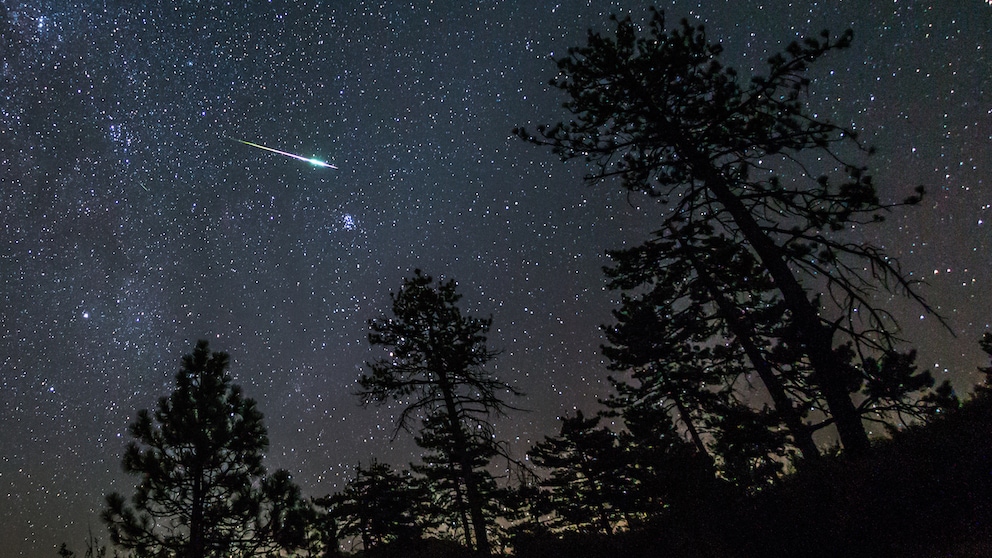September 17, 2024, 8:22 am | Read time: 4 minutes
Every year in August, the Perseids appear as shooting stars in the night sky. When the sky is clear, this natural phenomenon is easy to observe – and photograph. You don’t necessarily need expensive professional equipment to do this, but three things are essential. With them, you can even take pictures with your smartphone.
This year, the night from August 12 to 13 is likely to be the highlight of the Perseids shower. It is, therefore, the best opportunity to take spectacular pictures. Once a year, the Earth crosses the dust trail of comet 109P, also known as Swift-Tuttle, on its orbit. In 133 years, the comet moves around the sun and comes within 133,500 kilometers of the Earth. In doing so, it leaves behind the dust trail through which the Earth passes every year around August 12. On entering the Earth’s atmosphere, the small meteors burn up. This looks like a rain of shooting stars from the balcony at home. To observe this spectacle, you need a clear sky and a dark place with as little light pollution as possible. Once these conditions are in place, only three things are needed to take a good photo.
The perfect Perseids photo
Regardless of whether you have set up camp in the countryside at night or just on a balcony or roof, you should make yourself comfortable and be patient. All you need is a camera, a lens, and a tripod to capture the glowing orbits of the Perseids in a photo.
If you have a large SLR camera, you are well equipped. However, you can also achieve acceptable results with digital cameras if you can manually set the exposure time. Long exposures are used for night-time sky shots, which can trace the light trails of the meteors. The exposure time should be at least 30 seconds at the lowest possible ISO setting. This ensures that the image is not noisy.
A tripod is essential to ensure that the photo is not blurred during the long exposure so that the Perseids turn into blurred patches of light. If you don’t have one, you can also fix the camera in another way. If you place the camera on a railing or a table, the same rule applies as with Mikado: just don’t wobble. A remote shutter release can also help to prevent unintentional wobbling.
The third ingredient for a spectacular Perseids photo is a lens with a short focal length (24 mm or smaller). This covers a large part of the night sky and increases the chance of actually getting a shooting star in front of your lens. Although you can expect to see the Perseids in the northeast, you never know exactly where the next meteor will burn up. The faster the lens, i.e., the lower the f-number, the better.

These are the 7 best high-end compact cameras at a glance

What Is the Bokeh Effect in Photography and How Does It Work?

Samsung Galaxy A36 and A56 — New Mid-Range Hands-On
Capturing meteors with the smartphone camera
If you don’t have a camera or happen to be caught in the shower of stars, you can also pull out your smartphone. However, a lens with a short focal length and wide-angle is also helpful here. Apps such as ProCam (iOS) or ProCam X (Android) allow you to set the exposure time. The iOS camera app can also expose for several seconds in night mode. Google’s Pixel smartphones have an astrophotography mode. However, the same applies to smartphones: the phone should be as still as possible. If possible, you should work with a remote shutter release or automatic shutter release.
The best chances of seeing a rich Perseids shower are in the second half of Tuesday night, between two and four o’clock. If you don’t have time to photograph the Perseids on this night, you can also observe the meteors on the nights after August 12. According to the Rodewisch Observatory (Saxony), conditions are good this year. This is because the moon is only bright in the sky in the early evening. Otherwise, stargazers should be patient and enjoy.
There’s no need to worry about being hit by one of the celestial projectiles. The Perseids are meteors, which, by definition, burn up when they enter the Earth’s atmosphere and are only visible as a tail of light. On the other hand, the extraterrestrial solid bodies that are occasionally found on Earth are meteorites. If you don’t manage to take a look at the Perseids this year, you could enter the terms “meteor” and “meteorite” in the Google search for fun. At the moment, you may be in for a little surprise.
The German original of this article was published in August 2024.
With material from dpa

